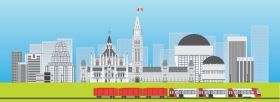Could the LRT help reduce greenhouse effect?
A rising trend in some countries, urban rail transit systems are an alternative to freight transport through cities.
Freight transit using existing urban railways could now be possible in Canada with some effort, according to Telfer School of Management at the University of Ottawa Professors Onur Ozturk and Jonathan Patrick. Their research shows that quality of life in cities can be improved by creating a model that helps reduce greenhouse effects, traffic congestion, and the risk of spills or serious accidents on the roads.
Their solution? The Freight on Transit (FOT) model. This system has the potential to alleviate some of the most devastating environmental challenges by reducing the number of trucks driving through our cities. During his appointment at Université Paris-Est Marne-la-Vallée, Professor Ozturk was involved in research that developed projects with industry collaborators, such as Public Transport Paris, with the purpose of creating more energy-efficient cities. They were looking for strategies that used existing transit infrastructure to move merchandise within the city. Professor Ozturk developed a framework of a decision-making model that allows the subway line to be shared between passenger trains and freight trains. A case study showed that the city reduced the number of trucks by 10,000 per year, eliminating nearly 290 tons of CO2 and 19 tons of nitrogen.
Continue reading at University of Ottawa.
Image via University of Ottawa.


